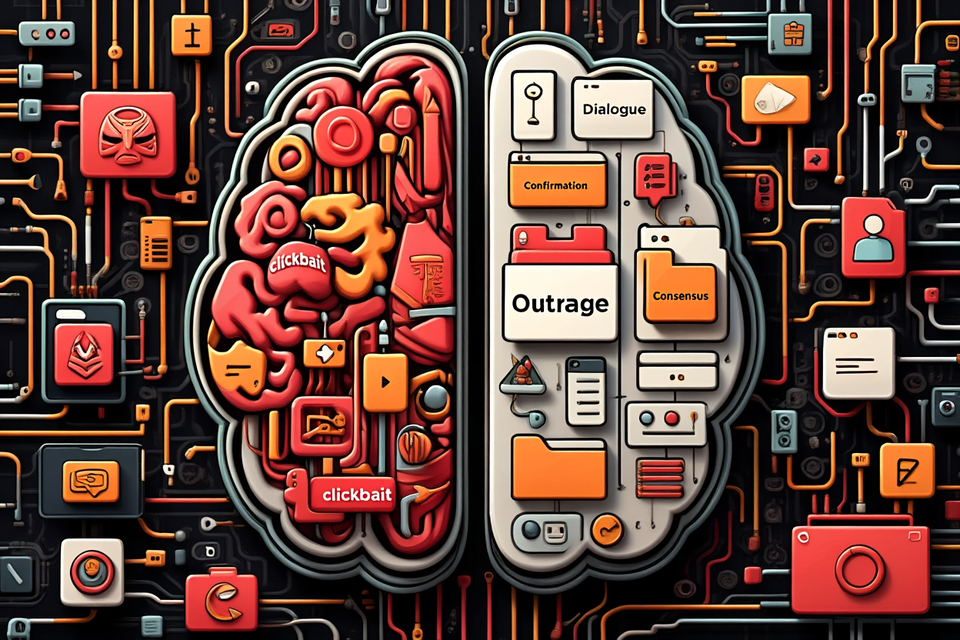Rebuilding Public Meaning: A Framework for Civic Journalism in the Age of Factionalism, AI, and Mediated Truth
Public discourse is breaking under noise, factionalism, platform logic, and unmitigated “free speech.” The repeal of the Fairness Doctrine and Citizens United opened the floodgates. PubHubs offers civic architecture to re-center truth, rebuild trust, and restore public purpose.

A White Paper by Dennis Stevens, Ed.D.

Executive Summary
This white paper proposes a structural and cultural shift in American broadcast journalism, using the PubHubs model as a foundation to design a values-based, community-moderated platform for public discourse.
It outlines how major media institutions, such as CNN, could adopt this framework to rebuild trust, engage with factional voices without collapsing into chaos, and reclaim the battle for public meaning.
Drawing from core insights in “Journalism in the Age of Factionalism and AI,” “Reframing the Frame,” and “Mediated Truths,” this project offers not a platform, but an architecture—where framing is transparent, AI is used with editorial oversight, and civic identity is relational rather than extracted.
The proposal addresses three intersecting crises: a fragmented epistemic landscape, eroding democratic norms, and a media economy that prioritizes engagement over public coherence.
1. The Crisis of Public Meaning in America
America’s media infrastructure is overwhelmed by the collapse of shared reference points. The fragmentation of trust—exacerbated by factional echo chambers, algorithmic amplification, and rhetorical drift—has not just divided audiences but destabilized the very conditions for collective deliberation.
As Stevens outlines in “Mediated Truths,” it is not just misinformation that distorts the public sphere, but the loss of common frames through which meaning is interpreted. In this context, neutrality is no longer neutral, and objectivity without accountability simply dissolves. The result is a saturated, contested, and emotionally charged information environment where truth becomes performative and power is exercised through the weaponization of language itself.
2. What is PubHubs? A Civic Architecture for Digital Public Space
PubHubs, a Dutch initiative, offers a compelling response. It is not a platform, but an infrastructure—an open-source, non-profit network of online “Hubs” managed by public-interest institutions (e.g. broadcasters). Each Hub is cryptographically secure, locally governed, and identity-aware without being surveillance-driven.
Its structure allows for moderated Rooms, attribute-based authentication (not full identity disclosure), and trusted, context-specific participation. PubHubs facilitates collective deliberation through global engagement, providing digital agency without commodifying attention. Most importantly, it places the governance of communication back in the hands of those accountable to public values, not venture capital.
3. Toward a CNN PubHub: Journalism as Civic Infrastructure
Applying PubHubs to a major broadcaster like CNN means redesigning its online presence as a deliberative commons, not just a content distribution channel. The CNN PubHub would host structured Rooms for factional forums, breaking news discussions, expert Q&As, explainers, and AI transparency labs.
Journalists and audiences alike would engage with one another not anonymously, but through moderated, transparent dialogue. Framing becomes visible—open to interrogation, revision, and accountability. Each Room could specify contextual identity requirements: “verified educator,” “local resident,” or “subject-matter contributor.” AI tools would assist—not replace—journalists by summarizing debate, identifying competing moral grammars, and surfacing epistemic tensions.
4. Language, Framing, and Narrative Power
As argued in “Reframing the Frame,” the power of journalism lies not just in what is reported, but in how it is framed—morally, emotionally, and semantically. A PubHub-based system enables media organizations to reveal frames, rather than hide them.
It encourages transparency about narrative positioning: Are we reporting through the lens of public safety, systemic injustice, or personal freedom? Rather than feigning neutrality, this system allows the public to inspect the framing logic and see how stories are shaped across ideological spectrums.
This is not relativism; this is structural literacy in service of shared meaning across inherently American fractured and dispersed communities of political knowledge and values.
5. Monetization Without Exploitation
Advertising is not excluded in the CNN PubHub-- it is reimagined. There is no user profiling, no tracking, no behavior-based targeting. Instead, monetization is driven through civic sponsorship, grant partnerships, and audience contributions, perhaps driven by a non-profit institute that advances news in the public interest.
Sponsorship is visible and theme-based (e.g., “Health Journalism supported by Kaiser Foundation”), never hidden in algorithmic ecosystems. This realignment moves CNN from an engagement-maximizing business model to a civic trust-maximizing institution. The economic model supports moderation, public deliberation, and technological stewardship without compromising the integrity of the space.
6. Public Deliberation in the Age of AI and Factionalism
PubHubs is not utopian—it is structured. It doesn’t eliminate conflict but organizes it through architectural logic. Factions, as described in “Journalism in the Age of Factionalism and AI,” are not failures of democracy but features of pluralism. The challenge is not to eliminate factions but to force their mutual recognition under conditions of fairness, moderation, and civic restraint. AI is neither threat nor savior—it is a tool.
When embedded in transparent systems, under editorial oversight, AI can reduce noise, surface common ground, and assist in frame recognition. But meaning-making must remain a human practice. The CNN PubHub would provide not “the truth,” but a place where truth can be publicly contested, revised, and held in civic tension.
7. AI-Mediated Disagreement: Toward Shared Ground in Digital Dialogue
In a media ecosystem where factions inhabit parallel realities, AI offers new potential, not to replace human judgment, but to help structure contested discussions.
As detailed in Stevens' article “AI Mediation in the War Over ‘Truth’,” AI systems like the "Habermas Machine" can successfully facilitate group deliberation even when direct dialogue fails. They do so by synthesizing diverse viewpoints into shared statements and inviting iterative feedback, which can surface contested frames and epistemic differences.
The core challenge, as the paper observes, lies in reconciling "different belief systems and epistemic architectures," especially in contested digital environments where platform logic shapes reality. AI must become part of the infrastructure of verification—highlighting the "battle for truth" by developing hybrid systems that combine human oversight with computational mediation.
A parallel argument appears in discussions of democracy and deep ideological divides, where frames and moral grammars differ radically across groups. In that context, AI can serve three practical functions within PubHubs-style civic platforms:
- Summarizing debates to surface core disagreements among factional forums.
- Highlighting moral and causal fault lines, helping participants and moderators recognize whether disagreements stem from differing values or factual interpretations.
- Facilitating iterative framing, generating statements that integrate minority perspectives and inviting participants to endorse, revise, or reject them, mirroring citizen assembly methods shown to improve consensus.
Academic research supports this structured intervention: the Habermas Machine, for example, achieved a unanimous consensus in nearly 39% of deliberative groups, up from 23% without AI mediation. Importantly, AI serves as an assistant to human judgment, not a substitute; it provides clarity, not content. By diagnosing whether a disagreement is factual or moral, summarizing competing frames, and offering synthesized proposals, AI becomes a tool of civic architecture rather than manipulation, reorienting public discourse toward recognition rather than reaction.
In our model for a CNN PubHub, AI mediation is embedded in a transparent, moderated infrastructure that supports framing awareness and deliberative integrity. This aligns with the goal of journalism not merely to report facts, but to shape the conditions under which meaning is constructed, contested, and shared.
8. Call to Action: A Pilot for Post-Platform Journalism
We call on CNN and peer institutions to pilot this new civic architecture. The future of journalism is not more virality or better click-through—it is trust, structure, and deliberation. The CNN PubHub is a prototype for how broadcast journalism can serve as civic infrastructure in our time of deep epistemic chaos.
By aligning with the PubHubs model, integrating frame-awareness, and applying AI responsibly, CNN can help reclaim the conditions for public meaning in America as news, as it relates to politics, serves the public interest.
For more information in Dutch, see:
Jacobs, Bart & van Dijck, José. PubHubs Position Paper (February 2023).
This paper outlines the vision behind PubHubs, a Dutch initiative aimed at creating secure, decentralized digital environments for public-interest organizations. Unlike commercial platforms driven by data extraction and global engagement, PubHubs is designed around privacy, proportional identity verification, local governance, and values-based moderation.
It offers a modular system where institutions, like broadcasters, can host their own moderated “Hubs” to foster deliberation and safe community interaction. PubHubs aims to rebuild digital trust by offering an alternative civic infrastructure rooted in public responsibility.
Read the full paper →




